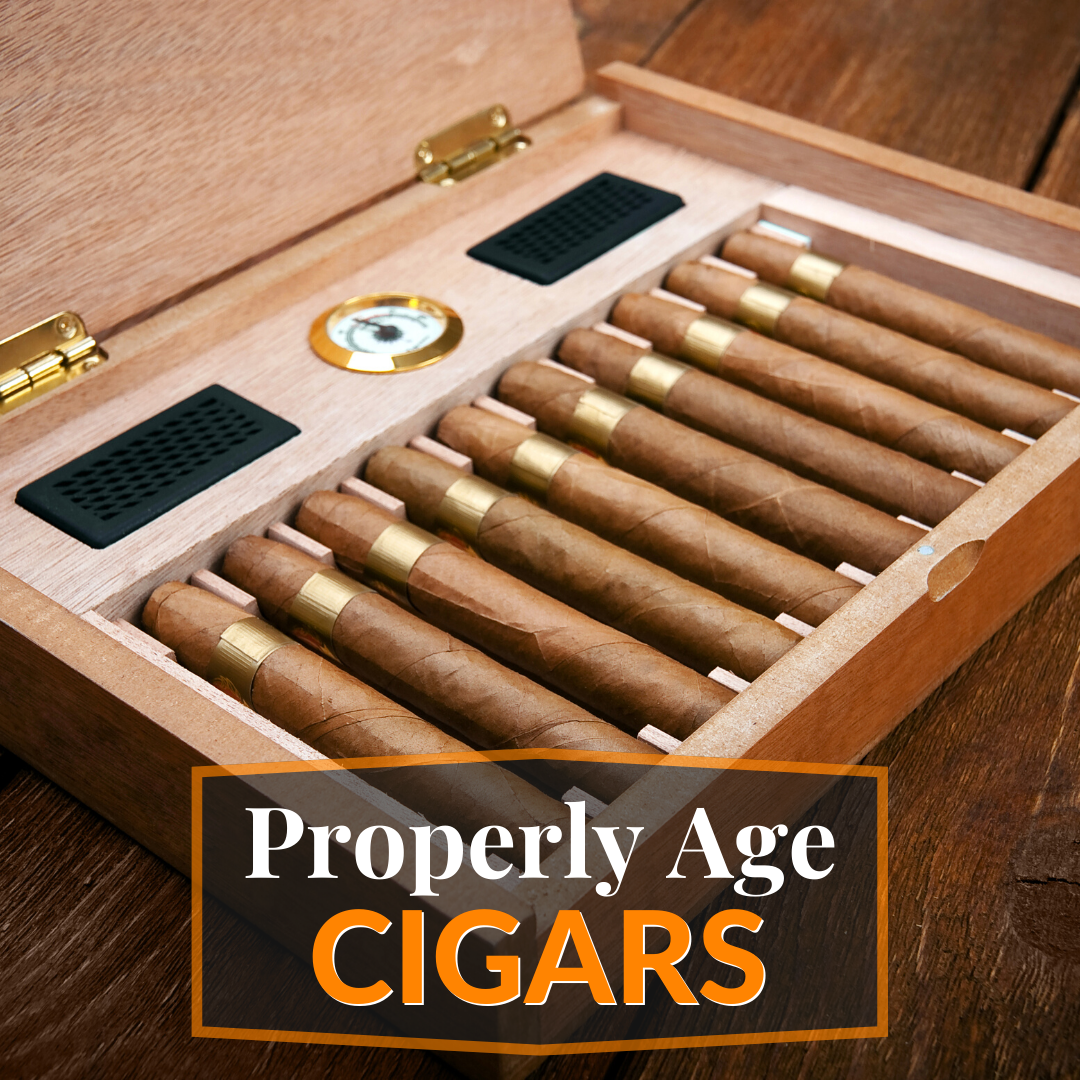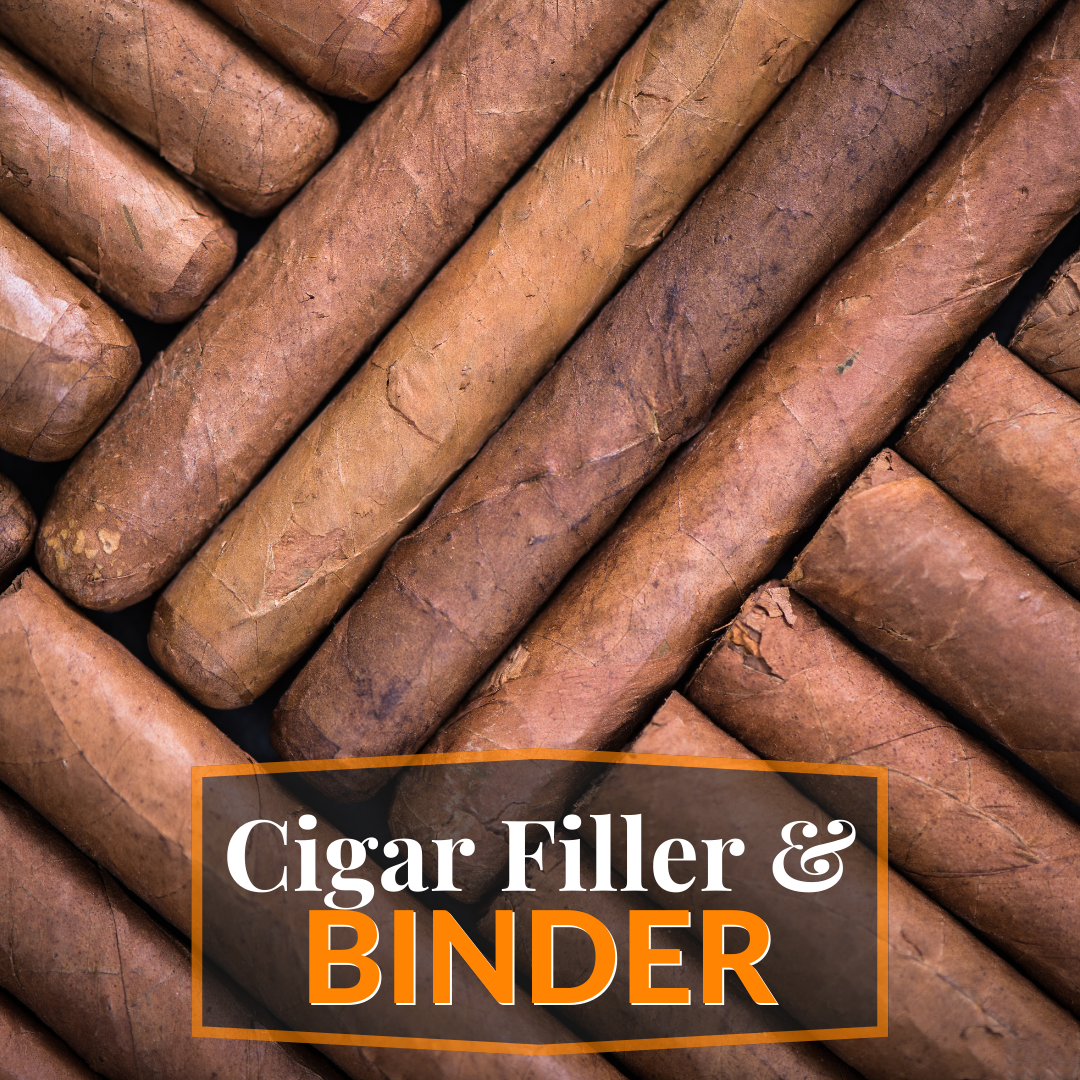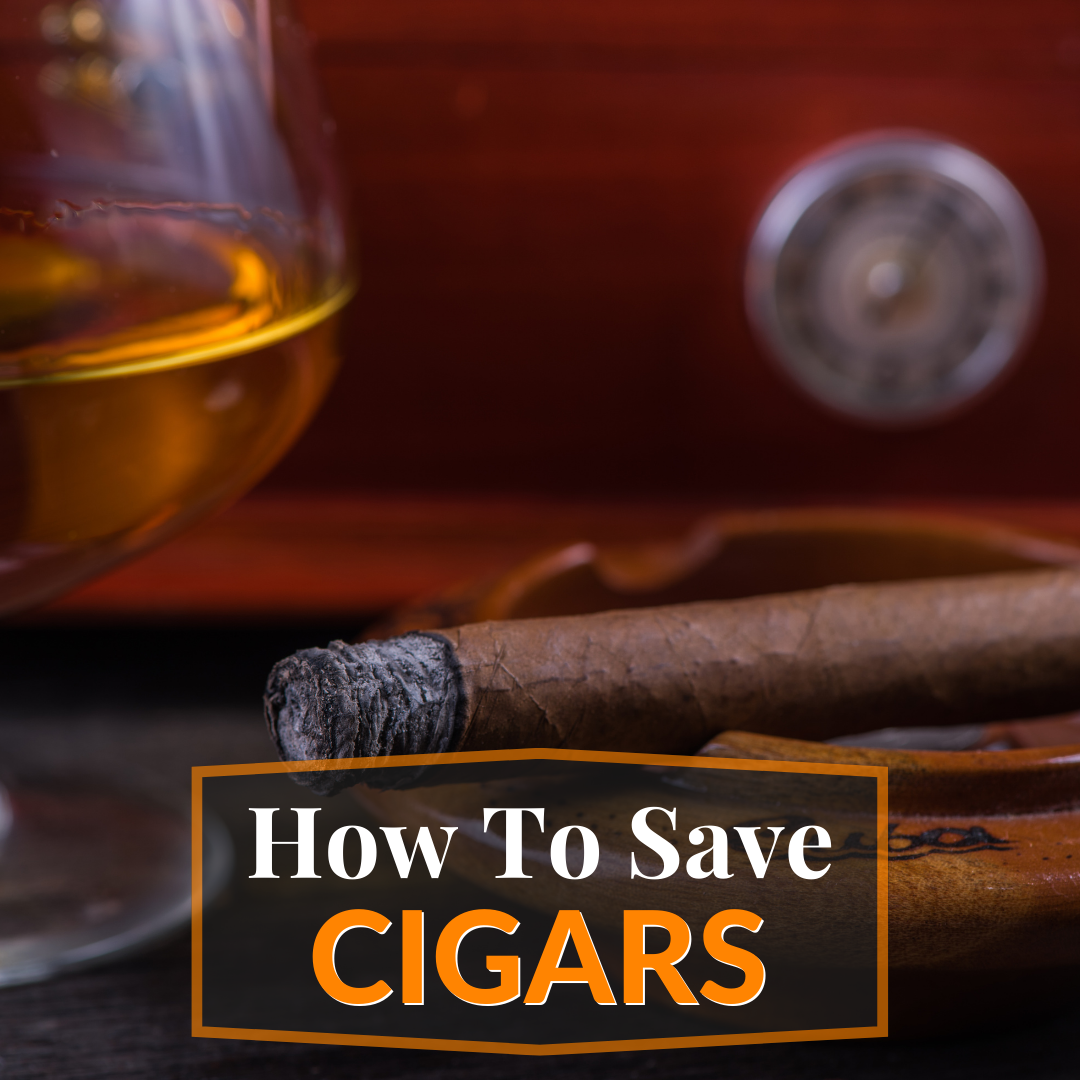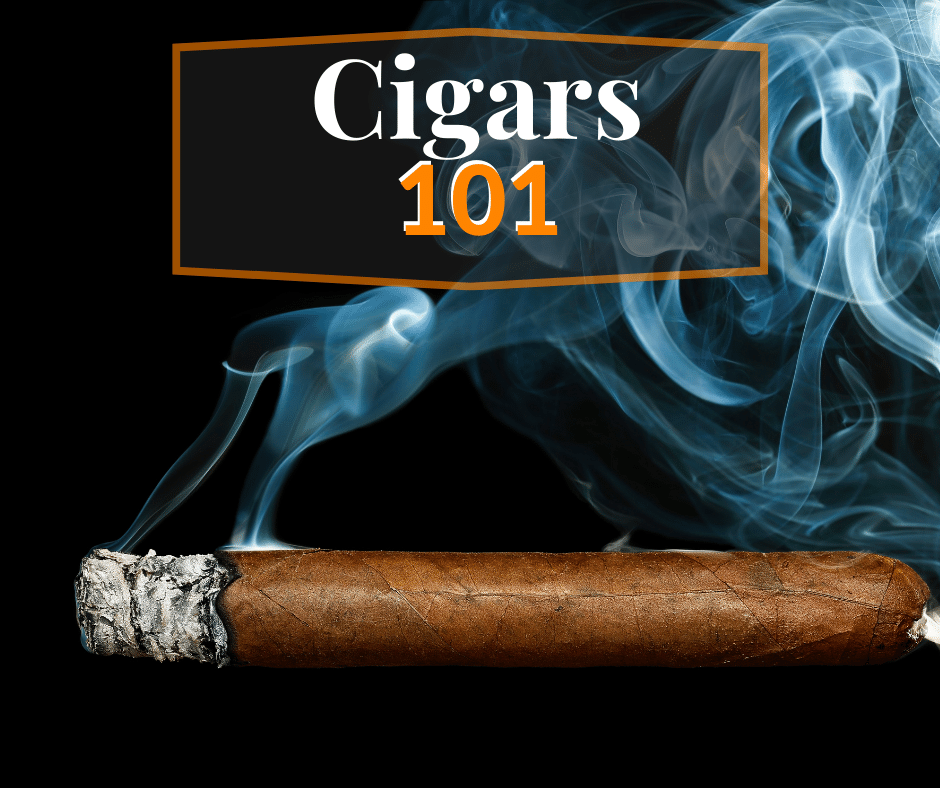
What is in Cigars? | Best Type of Cigar | Cigar Cutting | Cigar Wrapper Types | Cigar History | How Long Do Cigars Last? | Keeping Cigars Fresh | Why People Smoke Cigars | Cigar Taste | How To Smoke a Cigar | Inhaling Cigar Smoke | How Bad Are Cigars For You?
Cigars have long been a symbol of luxury, celebration, and relaxation. But have you ever wondered what makes a cigar special, or how to truly appreciate one? If you’re a novice or a seasoned aficionado looking to deepen your understanding of cigars, you’ve come to the right place!
In this Cigars 101 guide, we’ll explore the fascinating world of cigars, from their origins and history to their types and how to select, store, and enjoy them. You’ll also learn about the art of cigar making, and the role of various tobacco leaves and regions in shaping a cigar’s unique character. Whether you’re just starting out or seeking to elevate your cigar experience, this comprehensive guide will provide you with valuable insights and expert tips.
So, light up your curiosity and join us on this flavorful journey as we unveil the secrets of cigars! Get ready to impress your friends and indulge in the rich aromas and tastes of this timeless pleasure. Who knows, you might even discover your new favorite cigar along the way. Let’s dive in and immerse ourselves in the captivating world of cigars, guided by the expertise of renowned cigar connoisseurs.
What is in Cigars?

Have you ever found yourself pondering over the intricacies of cigars, perhaps while enjoying one yourself? What exactly is it that makes a cigar so unique and satisfying to many aficionados? There is definitely more than meets the eye when it comes to understanding the world of cigars.
Cigars are composed of carefully selected tobacco leaves, which undergo a meticulous fermentation and aging process to achieve their distinct flavors and aromas. As renowned cigar expert James Suckling once said, “A great cigar is like a great wine. They both have their unique characteristics and tastes.” Click the link below to go along with us as we explore the various components and craftsmanship that go into creating a fine cigar, from the wrapper and filler to the binder and even the intricate art of rolling.
Are you ready to embark on a fascinating journey into the world of cigars? We want to help you gain a deeper appreciation for these handcrafted works of art and the skill that goes into creating them. So, let’s light up our curiosity and dive into the captivating realm of cigars!
Click Here For More on: What Is In Cigars
What is the Best Type of Cigar?
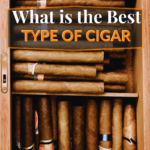
Cigars are enjoyed worldwide for their luxury and relaxing qualities, but with so many options available, choosing the best one can be difficult. This comprehensive guide covers the factors that determine cigar quality, popular cigar types, and tips for selecting the perfect smoke. Some of the important elements covered in the guide include the factors that determine cigar quality, popular cigar types, and tips for selecting the perfect smoke. Here are some of the highlights:
Factors That Determine the Quality of a Cigar:
- Wrapper
- Binder and Filler
- Tobacco
- Size and Shape
- Country of Origin
Popular Types of Cigars:
- Montecristo
- Arturo Fuente
- Oliva
- Padrón
Tips for Choosing the Perfect Smoke:
- Identify Your Taste Preferences
- Explore Different Brands and Regions
- Try Different Sizes and Shapes
- Store and Age Your Cigars
- Pair Your Cigar with Food and Drinks
- Practice Cigar Etiquette
Click Here For More On: What is the Best Type of Cigar
Cigar Cutting
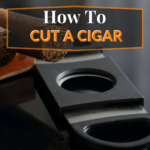
Cutting a cigar is a crucial step in the cigar smoking experience, as it ensures proper airflow, allowing for a smooth draw and even burn. Cigars are typically capped on the smoking end, and this cap must be removed before smoking to let the smoke pass through. Some common types of cigar cuts include the straight cut, V-cut, punch cut, and shuriken cut. Each type of cut affects the smoking experience differently, and the preferred method varies depending on personal preference.
To ensure a clean cut, use a sharp, well-maintained cutter appropriate for the cut type, position the blades just inside the end of the cap, and apply a firm, quick motion when cutting. It is not recommended to use a knife or teeth to cut a cigar, as it can lead to an uneven cut or damage the cigar’s wrapper.
A poor cut can negatively impact the smoking experience, as it can cause an uneven burn, poor draw, or the cigar unraveling during smoking. By using the proper cutter and cutting technique, one can ensure a satisfying smoking experience. Experimenting with different cutting methods can help find the one that suits individual preferences best. The art of cutting a cigar is an essential part of the smoking ritual, so it is important to take the time to learn and practice proper cutting techniques.
Click Here For More on: Cigar Cutting
Cigar Wrapper Types
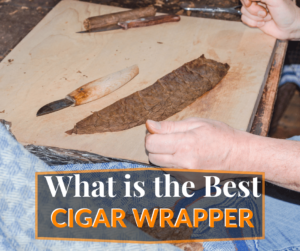
There are six prominent wrapper types: Connecticut, Corojo, Habano, Maduro, Oscuro, and Candela.
Connecticut Wrappers
Connecticut wrappers, grown in the United States and Ecuador, are characterized by their light, creamy flavor and smooth texture. They are ideal for beginners due to their mildness.
Corojo wrappers
Corojo wrappers, originating from Cuba, provide a spicy and robust flavor, making them suitable for experienced smokers.
Habano wrappers
Habano wrappers, also of Cuban origin, are highly sought after for their rich and bold flavors, ranging from spicy to sweet.
Maduro wrappers
Maduro wrappers undergo a lengthy fermentation process, resulting in a dark color and sweet, rich taste. These wrappers can be found in various countries, including Nicaragua, Honduras, and the Dominican Republic.
Oscuro wrappers
Oscuro wrappers, the darkest of all, boast a full-bodied flavor profile with a hint of sweetness.
Candela wrappers
Candela wrappers, known for their green color, provide a mild, grassy flavor that can be polarizing to some smokers.
Each wrapper type contributes to a unique flavor profile, making cigar smoking a diverse and enjoyable experience.
Click Here For More on: Cigar Wrapper Types
When Were Cigars Invented?

Cigars can be traced back to the ancient Mayans around 2000 years ago, who used tobacco leaves to create a smokeable item resembling the modern cigar. Christopher Columbus and his crew encountered tobacco during their voyage to the Americas in 1492, and it soon gained popularity in Europe.
In the 16th century, Spain established cigar factories, which contributed to the evolution of the cigar-making process.
The popularity of cigars skyrocketed in the 19th century, during which time the use of cigars became a symbol of sophistication and success. Famous figures such as Winston Churchill, Mark Twain, and Sigmund Freud helped solidify the connection between cigars and high social standing. Cigar production expanded globally, with countries like Cuba, the Dominican Republic, and Honduras becoming major producers.
The journey of cigars through different cultures and their refinement over time is an intriguing story of global trade and cultural exchange.
Click Here For More on: When Were Cigars Invented?
How Long Do Cigars Last?

When properly stored, cigars can maintain their quality for an extended period. However, various factors can impact a cigar’s lifespan, including humidity, temperature, and exposure to air.
To prolong the life of a cigar, maintaining a humidity level of 65-72% and a temperature of 65-70°F in a well-sealed humidor. The storage conditions are crucial for preserving the cigar’s flavor and aroma.
In the absence of a humidor, the site offers alternative methods such as using Tupperware or a Ziploc bag with a damp sponge or Boveda pack. These temporary solutions can help maintain the cigars for a few weeks to a couple of months.
It is very important of regularly rotate the cigars in the humidor, as this practice ensures even humidity distribution and prevents mold or tobacco beetles from damaging the cigars.
A word of caution, you do not want store cigars in a refrigerator, as the cold and dry environment can damage the cigars and affect their taste. Proper storage and care can significantly extend the life of cigars, allowing aficionados to enjoy them at their finest for years to come.
Click Here For More on: How Long Do Cigars Last?
How To Keep Cigars Fresh

Maintaining the freshness of cigars is crucial for preserving their taste and aroma. The ideal conditions for storing cigars are 70% relative humidity and 70 degrees Fahrenheit, as these prevent the cigars from drying out or becoming too moist. To create the perfect environment, follow these steps:
- Use a humidor: A humidor is a storage container designed to maintain the humidity and temperature required for cigar preservation. It can be made from various materials, with Spanish cedar being the preferred choice due to its moisture retention and odor neutralization properties.
- Calibrate your hygrometer: Regularly calibrating your hygrometer ensures accurate humidity readings, thus enabling better control of your humidor’s environment.
- Season your humidor: Before storing cigars, season your humidor by wiping its interior with a damp cloth, placing a bowl of distilled water inside, and waiting for the humidity to stabilize.
- Maintain humidity: Use distilled water, propylene glycol solution, or humidity beads to maintain humidity levels. Avoid tap water, as it can introduce contaminants that affect cigar quality.
- Store cigars properly: Remove cigars from their cellophane packaging and place them in the humidor without stacking them too tightly, as this can limit airflow and cause uneven humidity distribution.
- Rotate cigars: Rotate cigars every few months to ensure even exposure to humidity.
- Inspect cigars: Regularly check your cigars for mold or infestations, and separate any affected cigars from the rest.
By following these steps, you can ensure your cigars remain fresh and ready for enjoyment.
Click Here For More on: How To Keep Cigars Fresh
Why Do People Smoke Cigars?

Cigars provide an indulgent sensory experience, with their rich aroma, taste, and feel. The article emphasizes that cigar smoking is not just about nicotine intake, but also the enjoyment of flavors, craftsmanship, and the art of smoking. Cigars are often associated with special occasions and celebrations, where they are shared amongst friends and family, creating a sense of bonding and camaraderie.
Additionally, the process of choosing, cutting, and lighting a cigar can be considered a ritual that adds to the overall allure. There is also a significant social aspect of cigar smoking, as enthusiasts gather in lounges, clubs, and events to enjoy cigars together, fostering a sense of community.
Click Here For More on: Why Do People Smoke Cigars?
What Do Cigars Taste Like?

Cigars possess a wide range of tastes, depending on the type of tobacco used, how it is aged, and the overall craftsmanship. They are typically described in terms of strength (mild, medium, or full-bodied) and flavor profile (earthy, spicy, creamy, or sweet). While some cigars may have a single dominant flavor, others feature complex combinations. Many people enjoy pairing cigars with various beverages to enhance the tasting experience.
There are five basic tastes: sweet, sour, salty, bitter, and umami. Cigars may have traces of these tastes, with the primary flavor coming from the tobacco leaf. These flavors can be influenced by factors like the country of origin, climate, and soil.
We encourage beginners to start with mild cigars to ease into the experience and offers suggestions on how to properly taste and enjoy a cigar. Techniques such as retrohaling, where smoke is exhaled through the nose, can help to detect more subtle flavors.
Click Here For More on: What Do Cigars Taste Like?
How To Smoke a Cigar
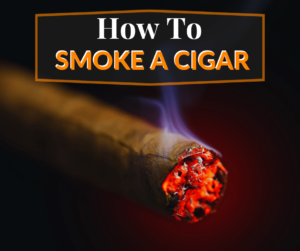
There are five essential steps for smoking a cigar, along with helpful tips for both beginners and seasoned smokers.
- Choose the right cigar: We recommend researching cigar brands and types before making a purchase. We can’t emphasizes the importance of quality over price enough and encourage you to explore different options to find a personal favorite.
- Prepare the cigar: Using a proper cutter to remove the cap, as well as a punch or V-cutter for a cleaner cut. We caution against using scissors or knives to avoid damaging the cigar.
- Light the cigar: Using a butane torch lighter or wooden matches is optimal for lighting. You want to avoid candles or petrol lighters. We also recommend toasting the foot of the cigar evenly to ensure a consistent burn.
- Smoke the cigar: When it comes to smoking, you want to take slow, gentle puffs without inhaling the smoke, allowing the flavors to develop. You may need to exercise a little bit of patience, as rushing the process can lead to a harsh or bitter taste.
- Savor the experience: Take your time and enjoy the different flavor profiles and nuances of a cigar. You may also enjoy pairing the cigar with a suitable beverage to enhance the overall experience.
By following these steps, smokers can elevate their experience and appreciate the art of cigar smoking.
Click Here For More on: How To Smoke Cigars
Why Don’t You Inhale Cigars?

The primary reason for not inhaling cigar smoke is due to the higher concentration of nicotine and other harmful chemicals. Inhaling this potent mixture can cause dizziness, nausea, and even nicotine poisoning.
Cigars are made from fermented tobacco leaves, which tend to contain more nicotine and other chemicals than the tobacco found in cigarettes. In addition, the larger size of cigars results in a more substantial amount of smoke, which can be overwhelming if inhaled. This is why cigar smokers prefer to savor the flavors by drawing the smoke into their mouths and exhaling without inhaling.
Inhaling cigar smoke can also irritate the lungs, as it is denser and contains more particulate matter than cigarette smoke. This can lead to coughing, wheezing, and other respiratory issues. Furthermore, the enjoyment of a cigar comes from the taste and aroma rather than the sensation of inhaling smoke. By not inhaling, cigar smokers can better appreciate the complex flavors and scents associated with the tobacco.
In conclusion, not inhaling cigar smoke is a conscious decision made by cigar smokers to avoid potential health risks and to fully experience the unique flavors and aromas of cigars. This practice helps to differentiate cigar smoking from cigarette smoking and contributes to the overall enjoyment of the experience.
Click Here For More on: Why You Don’t Inhale Cigars
How Bad Are Cigars For You?

Cigars have been long enjoyed by people seeking pleasure and relaxation, but just like cigarettes, they pose health risks. The harmful substances found in cigars are linked to various health issues, such as lung cancer, heart disease, and respiratory illnesses. Although cigars are often perceived as a safer alternative to cigarettes, they contain carcinogenic compounds and higher concentrations of toxins. The risks associated with cigars are amplified when they are inhaled, as with cigarettes.
Despite the common belief that occasional cigar smoking is harmless, any exposure to tobacco smoke can increase health risks. Moreover, cigar smoke is more toxic than cigarette smoke and contains higher levels of carbon monoxide, nitrogen oxides, and ammonia. Passive exposure to cigar smoke can also be harmful to non-smokers, contributing to secondhand smoke exposure. Though cigars may seem like a luxurious indulgence, it is essential to be aware of the potential risks and make informed decisions about their use.


